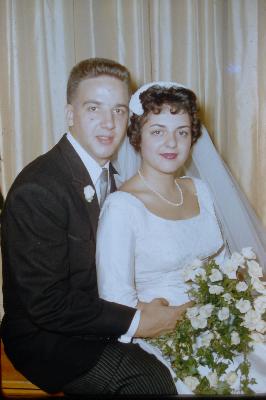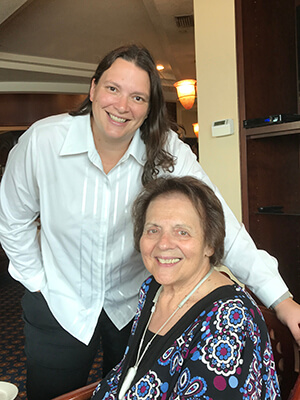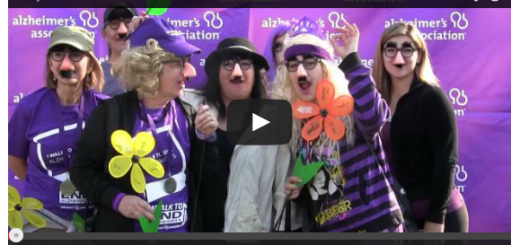Sacramento daughter walks to honor her mom’s legacy
With a family history of dementia, it was no surprise when Joyce started showing signs of dementia. Her daughter Melissa took over care for her mom and asked her to move in with her. There, Melissa and her wife cared for Joyce until her death. During that time, Melissa found the Alzheimer’s Association Walk to End Alzheimer’s® and has been doing everything she can to raise funds for a cure.
Dementia in the family
Melissa Wos grew up knowing that dementia ran in her family. As a young woman, Melissa’s aunt would confuse her with Joyce, Melissa’s mother. “When I got older, [my aunt] was the first person I knew who was bed-bound,” said Melissa. “I knew there was something [dementia related] on my side of the family.”
Joyce was an amazing cook who was kindhearted and vibrant. “She was the sweetest, kindest, most non-judgmental person,” said Melissa. “[She believed] everyone had a good side. You couldn’t get her riled up; it was so easy to be around her.”
Refusing to see a doctor
In 2013, as Melissa’s dad was dying of lung cancer, Melissa returned home from Florida to New York, where her parents lived. She noticed that her mother was asking the same questions about a story from the day before.
That April , Melissa’s father died and the day after his funeral she took Joyce to a neurologist. Melissa said, “The only reason I knew to go to a neurologist was because of our family history [of dementia].”
Joyce kept blaming her inability to answer the questions or draw a clock on the fact that she had just lost her husband. In the end Joyce was diagnosed with dementia.
Moving to Florida
Melissa convinced her mother to move down to Florida with her and her wife, Carrie. “I knew what this [disease] was going to be,” said Melissa. “I knew I’d have to convince her to move to Florida or I’d have to move back to New York.”
After the move, Carrie selflessly agreed to be her mother’s caregiver. Carrie would go on to care for Joyce for the next nine years. Melissa recounted, “Carrie said, ‘I’ll absolutely [care for your mom]. I love your mom, she’s like my best friend.’”
Walk to End Alzheimer’s
By the fall of 2014, Melissa and Carrie had found the Walk to End Alzheimer’s and attended their local event in Florida. “Mom used to walk with us too,” said Melissa. “She was one of the few with a blue flower. She didn’t understand what Walk was, but she attended. We were always one of the teams that raised the most money.”
The colors of the Promise Garden Flowers represent participants’ connection to Alzheimer’s — their reasons to end the disease.
- Blue: Someone living with Alzheimer’s or another dementia.
- Purple: An individual who has lost someone to the disease.
- Yellow: A person who is currently supporting or caring for someone living with Alzheimer’s.
- Orange: A participant who supports the cause and the Association’s vision of a world without Alzheimer’s and other dementia®.
Calling the Helpline
For the next several years, Joyce and Carrie did everything together. Joyce would talk to her cousins on the phone and tell them how much she loved the time Carrie spent with her.
However, as the disease progressed Joyce began crying all the time. No one, not even Joyce knew why. It was then that Melissa called the 24/7 Helpline at 800.272.3900. “I called the Alzheimer’s Association,” said Melissa. “I said I don’t know what to do, she won’t talk to me, she doesn’t know why she’s crying. [The next day] they sent over an intake person, who sat down with Mom. She got irritated and I’m fairly certain she was realizing [she had dementia]. The intake person and I went to another room and she recommended hospice.”
It’s hard to know what are the best care options to provide for your loved one, especially as they get closer to end of life. Hospice’s primary purpose is to manage pain and other symptoms during the last six months of life where treatments focus on comfort rather than curing the underlying disease.
“I lost it, ‘How dare you tell me hospice! She’s fine! She’s not dying tomorrow,” said Melissa. “The woman patiently said, ‘You can have hospice for a very long time, as long as the person is progressing. This is an incurable disease and that’s the reason I recommend it.’”
Melissa and Carrie put Joyce in hospice in 2018 and Melissa said it was “A huge blessing. It helped my wife in so many ways as [my mom’s] disease progressed.”
End of life
In 2021 Melissa and Carrie went to Las Vegas for a much-needed vacation but two days into their trip Hospice called and told them they needed to come home. A friend who was helping watch Joyce agreed with Hospice and encouraged them to come home.
Joyce had reached the point in the disease where she had forgotten how to swallow. With the help of hospice, end of life decisions were made, and Joyce died seven days later.
A donation for science
After Joyce’s death, Melissa had her mother’s brain donated to the University of Miami. Because of this, Melissa learned that Joyce had dementia with Lewy bodies (DLB). DLB is a type of progressive dementia that leads to a decline in thinking, reasoning and independent function.
“I know it’s hereditary and I wanted answers,” said Melissa. “[The college said they’d] never seen a brain that infiltrated with beta amyloid, but she had it everywhere. They told me [her brain] will be used in a ton of case studies and I’m happy about that.”
Moving to Sacramento
After the death of her mother, Melissa and Carrie moved to Sacramento, California and one of the first things they did was find the local branch of the Alzheimer’s Association. Once connected, Melissa joined the Walk Committee for the Walk to End Alzheimer’s in Sacramento.
Committee members play a key role in the success of each event, from getting local companies involved to helping participants engage with our mission to planning the event experience.
“For me, I love volunteering, and I love giving back,” said Melissa. “If you don’t know somebody now, you will. [This disease is] not going away, it’s not reducing numbers. Having that comradery and knowing you’re not alone and there are other people going through it. What a different feeling it is when people understand.”
Company involvement
Melissa is currently working with her employer, Apple, to encourage her fellow employees to volunteer on Walk day.
“I’m hoping for 40-100 volunteers from Apple,” said Melissa. “$25 per hour, for four hours times 40 volunteers, that’s $4,000!”
After participating in Sacramento’s Walk she was pleased to find that many people fundraise more than her.
“This disease is no joke and we need to figure it out,” said Melissa. “[Walk] is how we raise money and find a cure. [My donations are] a drop in the bucket in Sacramento. I love it. I was blown away by how many people were at Walk, and how much money was raised. It’s mind blowing.”
Carrie finds her purpose
Because of her time spent caring for Joyce, Carrie has found that she truly loves being someone’s companion. Currently, Carrie is a companion to a woman whose daughter is also part of the Walk Committee.
“My goal is to have Carrie never work again,” said Melissa. “Carrie said, ‘I really like caregiving. I know how hard it is to find a me and I think other families would be appreciative of a me.’”
Get your affairs in order
Melissa encourages all caregivers to contact the Alzheimer’s Association right away. She also urges caregivers to get their affairs in order, like power of attorney, their will and any other wishes their loved one might have.
“You don’t know what you don’t know,” said Melissa. “Go to a support group, go to therapy. Get their last wishes taken care of. The Alzheimer’s Association will tell you about [treatments] and trials going on. I couldn’t have done half of what I did without having [the Association] in my corner.”
You can donate to Melissa’s team, Everyone Loves Joyce, or start your own team for the Walk to End Alzheimer’s – Sacramento on September 28, 2024. Not in Sacramento? Visit alz.org/walk to find a Walk near you.





















